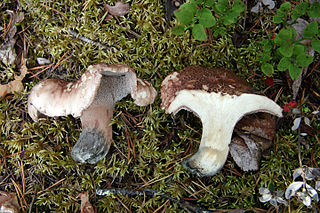
Nuclear distribution protein nudE-like 1 is a protein that in humans is encoded by the NDEL1 gene.

Eukaryotic peptide chain release factor GTP-binding subunit ERF3A is an enzyme that in humans is encoded by the GSPT1 gene.

Transcription regulator protein BACH2 is a protein that in humans is encoded by the BACH2 gene. It contains a BTB/POZ domain at its N-terminus which forms a disulphide-linked dimer and a bZip_Maf domain at the C-terminus.

Disintegrin and metalloproteinase domain-containing protein 22, also known as ADAM22, is an enzyme that in humans is encoded by the ADAM22 gene.

Hydnellum is a genus of tooth fungi in the family Bankeraceae. Widely distributed in the Northern Hemisphere, the genus contains around 40 species. The fruitbodies of its members grow by slowly enveloping nearby bits of grass and vegetation. There is great variability in the form of Hydnellum fruitbodies, which are greatly influenced by environmental conditions such as rainfall and humidity, drying winds, and temperature. They are too tough and woody to eat comfortably. Several species have become the focus of increasing conservation concern following widespread declines in abundance.

Phellodon is a genus of tooth fungi in the family Bankeraceae. Species have small- to medium-sized fruitbodies with white spines on the underside from which spores are released. All Phellodon have a short stalk or stipe, and so the genus falls into the group known as stipitate hydnoid fungi. The tough and leathery flesh usually has a pleasant, fragrant odor, and develops a cork-like texture when dry. Neighboring fruitbodies can fuse, sometimes producing large mats of joined caps. Phellodon species produce a white spore print, while the individual spores are roughly spherical to ellipsoid in shape, with spiny surfaces.

Sarcodon is a genus of fungi in the family Bankeraceae, which is part of the order Thelephorales, known for its almost universal ectomycorrhizal ecology. The genus owes its name to the presence of teeth-like spines on the hymenophore, from ancient Greek; sarco = flesh and odon = tooth. For this reason they are commonly called "tooth fungi", or "Hydnoid fungi".

Steccherinum is a widely distributed genus of toothed crust fungi in the family Steccherinaceae.

Substituted tryptamines, or serotonin analogues, are organic compounds which may be thought of as being derived from tryptamine itself. The molecular structures of all tryptamines contain an indole ring, joined to an amino (NH2) group via an ethyl (−CH2–CH2−) sidechain. In substituted tryptamines, the indole ring, sidechain, and/or amino group are modified by substituting another group for one of the hydrogen (H) atoms.
In molecular biology mir-326 microRNA is a short RNA molecule. MicroRNAs function to regulate the expression levels of other genes by several mechanisms.

Hydnellum glaucopus is a species of tooth fungus in the family Bankeraceae. Found in Europe, it was described as new to science in 1969 by mycologists Rudolph Arnold Maas Geesteranus and John Axel Nannfeldt. Fruit bodies contain cyathane diterpenes called glaucopins that have anti-inflammatory activity in laboratory tests. It is considered vulnerable in Switzerland.
Hydnellum lundellii is a species of tooth fungus in the family Bankeraceae. Found in Europe, it was described as new to science in 1969 by mycologists Rudolph Arnold Maas Geesteranus and John Axel Nannfeldt.
Sarcodon regalis is a rare species of tooth fungus in the family Bankeraceae. It was described as new to science in 1975 by Dutch mycologist Rudolph Arnold Maas Geesteranus. It is found in Europe, where it usually associates with oak and sweet chestnut; pine has been reported as another associate. Fruit bodies have yellowish-brown, convex to flattened caps up to 10 cm (3.9 in) in diameter. The surface features adpressed scales that are broadest in the centre, narrowing toward the margin. The spines on the cap underside are 1.5–3 mm long; initially pale, they become brown to purplish brown after the spores mature. The spores are roughly spherical, measuring 5–6.5 by 4–5 μm.
Sarcodon quietus is a species of tooth fungus in the family Bankeraceae. Found in the Congo, it was described as new to science in 1967 by Dutch mycologist Rudolph Arnold Maas Geesteranus.
Sarcodon procerus is a species of tooth fungus in the family Bankeraceae. Found in the Democratic Republic of the Congo, it was described as new to science in 1967 by Dutch mycologist Rudolph Arnold Maas Geesteranus. Its spores measure 6.7–8 by 4.5–5.4 µm.
Hydnellum lepidum is a species of tooth fungus in the family Bankeraceae. Found in Europe, it was described as new to science in 1975 by Dutch mycologist Rudolph Arnold Maas Geesteranus.

Hydnellum martioflavum is a species of tooth fungus in the family Bankeraceae, found in Europe and North America.

Sarcodon thwaitesii is a species of tooth fungus in the family Bankeraceae. It is found in Asia, Europe, and New Zealand, where it fruits on the ground in mixed forest.

Sarcodon leucopus is a species of tooth fungus in the family Bankeraceae. Found in Asia and Europe, it was described as new to science in 1825 by Christian Hendrik Persoon. Mycologists Rudolph Arnold Maas Geesteranus and John Axel Nannfeldt transferred it to the genus Sarcodon in 1969. Fruit bodies of the fungus have flattened to slightly depressed caps up to 20 cm (8 in) in diameter. The surface texture, initially finely felt-like, later cracks to form shiny scales. Its color is pale purplish-brown to dark brown. The stipe measures 4–8 cm (1.6–3.1 in) long by 2–6 cm (0.8–2.4 in) thick. Spines on the cap underside are up to 15 mm long and about 1 mm thick. The flesh has a disagreeable odor, and a bitter taste. Spores are roughly spherical, typically measuring 7.2–7.9 by 4.5–5.6 µm. The fungus is considered endangered in Switzerland.

Hydnellum scabrosum, also called bitter tooth or bitter hedgehog, is a species of tooth fungus in the family Bankeraceae.













